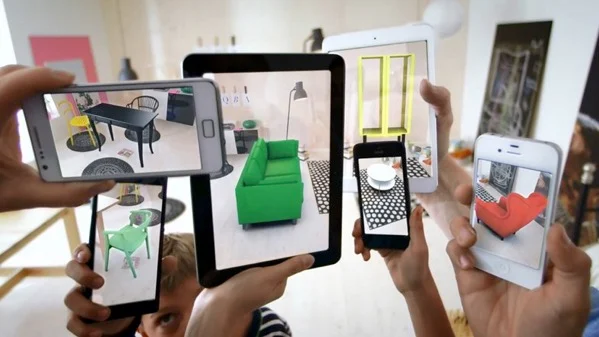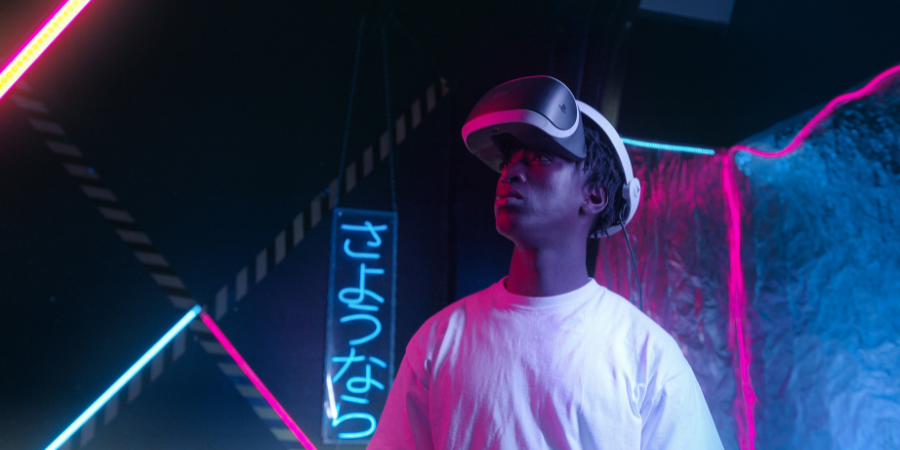Virtual reality (VR) is no longer just a thing of science fiction! It’s a fully-immersive, interactive experience that’s blowing minds left and right.
Forget about boring old movies and console games, Virtual Reality is where it’s at! But the fun doesn’t stop there, businesses are also getting in on the Virtual Reality game and using it for all sorts of cool purposes.
Gone are the days of clunky cardboard headsets, in 2023 Virtual Reality technology has come a long way baby! Let’s dive into the exciting world of VR, its business uses, and why we should all be eagerly anticipating the future of Virtual Reality.
Let’s Know About Virtual Reality


Virtual reality (VR) is like stepping into a whole new world, a fully immersive 3D environment that you can explore, move around in and even interact with using a fancy headset and some cool controllers.
It’s not just for gamers, it’s got the potential to revolutionize entertainment, marketing, remote collaboration, training, and education.
Unlike other forms of media like movies and video games, virtual reality uses wearable hardware to fully immerse the user in the experience. It’s like being in the Matrix, but without the fear of being unplugged.
And get this, the market is expected to grow from $4.2 billion in 2022 to a whopping $7 billion in 2023! It’s like virtual reality is taking over the world, and we’re here for it.
Virtual reality is not a size-fits-all kinda thing, there are different types of experiences that you can have depending on the hardware you have and the environment you’re in.
But don’t worry, we’ve got you covered, we’ll break it down for you into four categories that follow the history and evolution of VR as a technology.
Non-Immersive Virtual Reality
This is when you can interact with a virtual environment without leaving your physical reality. Think of it like playing a video game where you control a character in a virtual world, but you’re still sitting in your room.
Non-immersive VR is the building block to understanding what we consider “real” VR today. It’s like the training wheels for virtual reality.
Semi-Immersive VR
This is what most of us think of when we hear the words “virtual reality”. It uses the hardware you already have, like your smartphone, to match the motion and direction of your phone with the virtual experience.
It’s semi-immersive because it can give you the sensation of moving through a virtual space but your physical movement doesn’t play a part in the experience.
You can get low-cost headsets that enhance semi-immersive VR, like Google Cardboard, where your smartphone acts as both the display and the processor for VR-enabled mobile apps.
It’s a great way to get your feet wet in the virtual reality world without breaking the bank. Plus, it’s a great medium for marketing, since it’s easy to produce and consume the content compared to fully immersive VR.
Fully Immersive Virtual Reality
This is the crème de la crème of virtual reality, it’s the most advanced form and it requires some specialized hardware. When you’re in fully immersive VR, you’re wearing a headset that has built-in or external sensors to track your movements in physical space and provide a super realistic 3D experience.
In the past, fully immersive VR was a big commitment, it cost over $2,000 for a top-tier VR device, controllers, a powerful gaming PC or console, and mounted cameras – not to mention a dedicated space to set it all up. And sometimes, you’d trip over the wire tethered to the headset and it would break the immersion.
But, the Meta Quest 2 headset (formerly Oculus) release in 2020 changed everything, it brought the price down in line with smartphones and tablets and eliminated the need for a tethered connection and dedicated space, making fully immersive VR more accessible and portable.
Plus, they’ve added new features to make the experience even more realistic like hand tracking, where you can use your bare hands to interact in VR, and haptic feedback, which uses vibrations in the headset and controllers to mimic collision with virtual objects and walls. It’s like you’re there.
Mixed reality Virtual Reality
Mixed reality (MR) is like the wild child of VR, it takes things in a different direction. Instead of placing you in a virtual world, it brings virtual objects into your world by adding a layer of augmented reality (AR) over a view of your immediate environment.
Think of it like having a magic mirror, you can try on clothes, makeup, and even furniture in your own space. It’s like having a personal stylist or interior designer right in your living room.
You don’t even need fancy equipment, the simplest forms of mixed reality only require your smartphone’s browser and camera. But, if you want to step up your game, there are headsets and VR glasses that will further the experience by interacting with the environment or even recreating an environment in virtual reality.
Business and Enterprise Benefits of Virtual Reality
VR is not just for gamers, it’s also an exciting tool for businesses and companies. While it may not be immediately obvious, there are so many ways VR can help businesses, and we’re just scratching the surface.
From remote collaboration to immersive training, the possibilities are endless. Imagine being able to explore a virtual office, attend virtual meetings with colleagues from all over the world, or even train for a dangerous job in a safe virtual environment. The future is looking bright for VR in the business world.
Ready to dive into the virtual world of e-commerce? Here’s how to make it happen:


- Set your VR goals. Are you looking to make a splash with a unique shopping experience? Give customers a more hands-on way to check out your products. Cut down on returns with detailed product info. Figure out what you want to achieve before you start.
- Decide on the type of experience you want to offer. Will it be an experience-based adventure like North Face’s Yosemite VR? A product-focused demo like Audi’s? An interactive hangout spot where shoppers can play with products and chat with friends? The possibilities are endless!
- Get your VR team together. You’ll need developers who know their way around VR, and the right hardware to make it all happen. Whether you’re setting up a room-scale experience in-store or something more accessible for at-home use, make sure you’ve got the tech to match your goals.
- Test, test, test. Make sure the technical side is solid and the user experience is seamless. No one wants to feel nauseous while they’re shopping!
- Let the world know! You’ve built something cool, now it’s time to show it off. Remember that you’re still marketing your store and products, VR is just the tool you’re using to do it. And don’t be afraid to give away VR headsets to get people excited about your virtual store.
Step into a whole new world with virtual reality (VR) and take your online store to the next level!
With VR, you can create an unforgettable customer experience that will have them talking and sharing on social media. Your brand will be the talk of the town, as VR immerses consumers in a whole new world, creating a deeper connection with your brand.
Plus, VR technology can mimic the real-world experience, allowing customers to look at your products from every angle and understand their scale and proportions. This means that customers will be more confident in their purchases, leading to an increase in conversion rates and a decrease in returns.
So, what are you waiting for? Join the VR revolution and give your customers the ultimate shopping experience.
Diving deeper into customer behavior with VR
VR technology allows businesses to take a closer look at how customers interact with their virtual products and experiences. From eye movements to how a user interacts with a virtual object, the data collected can provide valuable insights for retailers to improve their customer experience.
Imagine being able to track a customer’s every move in a virtual store, like a heat map of their gaze, and use that information to optimize the layout and design of your virtual store. The possibilities are endless with VR analytics!










